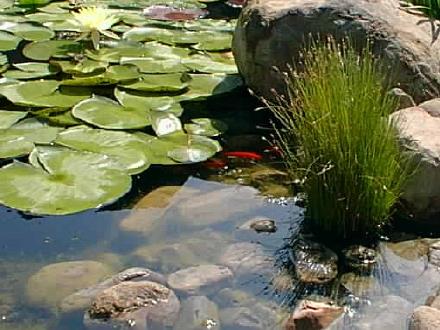The remarkable chemical and physical properties of water, primarily resulting from hydrogen bonding, have major consequences for all living organisms.
The properties of water place limits on organisms — on their physiology, anatomy, behavior, distributions, and evolution — but simultaneously provide evolutionary and ecological opportunities.
1. Hydrogen bonding means that water molecules are cohesive (they ‘stick’ to one another and to other polar molecules) and that surface tension makes air-water boundaries distinctive microhabitats.
We will focus on these consequences of hydrogen bonding for organisms as varied as tall trees, tiny caterpillars, mosquito larvae, and ducks.
2. Pure water freezes at 0C but is most dense at 4 C. That is, solid water (ice) is less dense than cold liquid water.
This means the difference between survival and death for many aquatic animals, and affects nutrient availability and biological diversity in temperate lakes. It also raises the question of how plants and animals, whose cells are essentially bathed in water, can survive subzero temperatures.
3. Water has a high heat capacity: it takes much more heat to raise the temperature of a volume of water than the same volume of air.
This property of water is a major determinant of global climates and rates of global climate change. We will not focus on this immeasurably important consequence of water’s specific heat, but will instead focus on the thermal biology of individual animals.
4. The three factors listed above will probably be all that we can cover in one class meeting. These are not, however, the only important physical and chemical properties that affect living organisms.
Another significant property, for example, is the solubility of oxygen molecules in water. The fact that oxygen molecules are less abundant and diffuse more slowly in water than in air has been a strong selective force in the evolution of respiratory systems in both terrestrial and aquatic animals.
We can predict a lot about life from the physical and chemical properties of water. Does this mean that chemistry and physics are sufficient to understand how living organisms deal with water? No…
Chemistry and physics alone cannot explain or predict the diversity of ways that organisms exploit water’s properties and overcome its limitations. To understand how water is important in biology we also need to understand the ubiquitous influences of evolutionary history and natural selection.
In your field trip on Thursday with Dr. Paul Gier you will see a diversity of freshwater vertebrates and invertebrates and will be able to relate many of their adaptations to the properties of water described here.
Professor Linda S. Fink
Source: http://witcombe.sbc.edu/
Dear User/Visitor! Please, answer on our questions: tick off one of the positions – your answer will make us able to improve our site and make it more interesting and useful!


